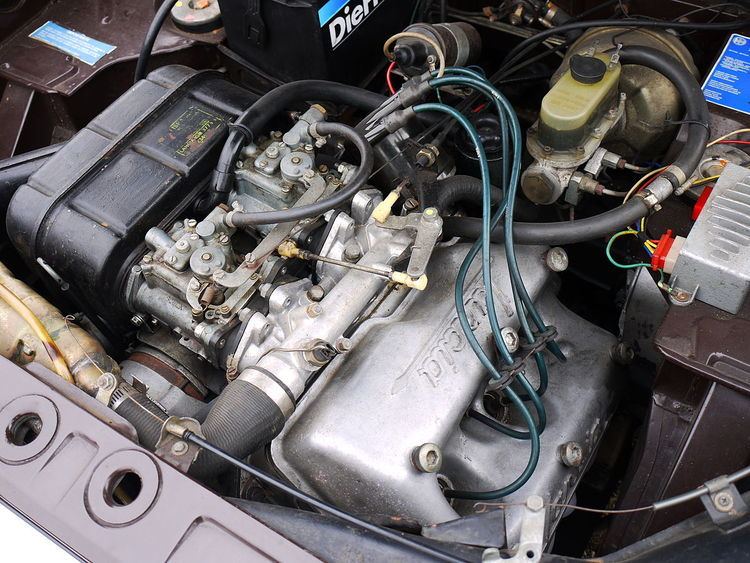Production 1922-1976 | ||
 | ||
Configuration 10° V4 engine11° V4 engine13° V4 engine20° V4 engine Displacement 903 cc (55.1 cu in)1,090 cc (67 cu in)1,091 cc (66.6 cu in)1,196 cc (73.0 cu in)1,199 cc (73.2 cu in)1,216 cc (74.2 cu in)1,231 cc (75.1 cu in)1,298 cc (79.2 cu in)1,352 cc (82.5 cu in)1,486 cc (90.7 cu in)1,584 cc (96.7 cu in)1,927 cc (117.6 cu in)2,119 cc (129.3 cu in)2,370 cc (145 cu in)2,568 cc (156.7 cu in) Cylinder bore 65.0 mm (2.56 in)69.85 mm (2.750 in)72.0 mm (2.83 in)74.61 mm (2.937 in)75.0 mm (2.95 in)78.0 mm (3.07 in)79.37 mm (3.125 in)82.0 mm (3.23 in)82.55 mm (3.250 in) Piston stroke 67.0 mm (2.64 in)68.0 mm (2.68 in)69.7 mm (2.74 in)75.0 mm (2.95 in)78.0 mm (3.07 in)82.0 mm (3.23 in)85.0 mm (3.35 in)90.0 mm (3.54 in)120 mm (4.7 in) | ||
Italian automobile company Lancia were the first to manufacture cars with V4 and V6 engines in series-production. This started with a number of V4-engine families, that were produced from the 1920s through 1970s.
Contents
The Lancia V4 pioneered the narrow-angle V engine design, more recently seen in Volkswagen's VR5 and VR6 engines. By using very shallow V-angles — between 10° and 20° — both rows of cylinders could be housed in an engine block with a single cylinder head, like a straight engine.
A determining characteristic was the use of overhead camshafts (either single or double), in which a camshaft would serve the same function for all cylinders — in both cylinder banks.
Lambda
The first V4 was used in the Lambda from 1922 through 1931. It was a narrow-angle aluminum design. All three engine displacements shared the same long 120 mm (4.7 in) stroke, and all were SOHC designs with a single camshaft serving both banks of cylinders.
Engines:
Artena
The Lambda engine was updated for the Artena. Bore was set at 82.55 mm (3.3 in) as in the 2.6 L Lambda, but stroke was reduced to a more conventional 90 mm (3.5 in). Total displacement was 1,927 cc, with 55 hp (41 kW) produced at 4,000 rpm.
Augusta
An all-new V4 was designed for the Augusta. Produced from 1934 through 1938, the Augusta's engine displaced just 1,196 cc with a 69.85 mm (2.8 in) bore and 78 mm (3.1 in) stroke. Power output was 35 hp (26 kW) at 4,000 rpm.
Aprilia
The engine was redesigned again for 1936's Aprilia. The first-series cars used a 1,352 cc version with a 72 mm (2.8 in) bore and 82 mm (3.2 in) stroke. Output was 47 hp (35 kW) at 4,300 rpm.
A second series was unveiled for 1939 with an enlarged 1,486 cc engine. It did not share its predecessor's dimensions, with bore now at 74.61 mm (2.9 in) and stroke at 85 mm (3.3 in). Power output was nearly the same at 48 hp (36 kW).
Ardea
A small V4 (tipo 100) powered the compact 1939 Ardea. It was a 20° narrow-angle engine displacing just 903 cc. Bore and stroke were new again at 65 mm (2.6 in) by 68 mm, and output was just 28.8 hp (21.5 kW). For the 1949 tipo 100B power was increased to 30 hp (22 kW).
Appia
The V4 returned after the war with the 1953 Appia. It featured an even narrower 10° cylinder bank and just 1,090 cc of displacement. An initial 38 hp (28 kW) of power grew to 43 hp (32 kW) in 1956. 48 hp (36 kW) was available in 1959.
Fulvia
Lancia's final V4 series were used in the Fulvia, remaining in production up until 1976. Designed by Zaccone Mina, it used a narrow angle (13°) and was mounted well forward at a 45° angle. The engine was a true DOHC design with one camshaft operating all intake valves and another operating all exhaust valves.
Displacement began at just 1,091 cc with 59 hp (44 kW) with a 72 mm (2.8 in) bore and 67 mm (2.6 in) stroke. A higher (9.0:1) compression ratio raised power to 71 hp (53 kW) soon after.
The engine was bored to 6 mm (0.2 in) to enlarge engine displacement to 1,216 cc for the Coupé model. This, and some tuning, raised output to 80 hp (60 kW), furtherly enhanced up to 88 hp (66 kW) for the HF model.
The engine was reengineered with a slightly narrower bank angle and longer (69.7 mm) stroke for 1967. Three displacements were produced: 1,199 cc (74 mm bore), 1,231 cc (75 mm bore), and 1,298 cc (77 mm bore). The latter engine is most common, with the first unit only sold in Greece. Three level of performance were available: 87 hp (65 kW) for common 1.3 Liter (commonly imported in USA and described as "highly tuned" by Road & Track at the time); 90 hp (67 kW) for its 1.3s evolution and 101 hp (75 kW) for the Rallye HF.
The engine was redone again for a new HF with an even-narrower angle (11° now) and longer 75 mm (3.0 in) stroke for its final incarnation. A bore of 82 mm (3.2 in) gave it a displacement of 1,584 cc, and power shot up to 114 to 132 hp (85 to 98 kW) depending on tune.
